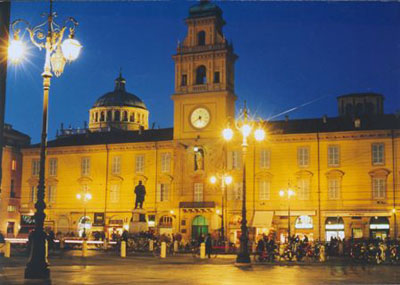Italian town: Parma
Parma is a city in the Italian region of Emilia-Romagna famous for its ham, its cheese, its architecture and the fine countryside around it. It is the home of the University of Parma, one of the oldest universities in the world. Parma is divided into two parts by the little stream with the same name. Parma’s Etruscan name was adapted by Romans to describe the round shield called Parma.
It has many sights to see:
Churches
▪ The Romanesque Cathedral houses both 12th century sculpture by Benedetto Antelami and a 16th century fresco masterpiece by Antonio da Correggio.
▪ The Baptistery, adjacent to the cathedral was begun in 1196 by Antelami.
▪ The abbey church of Saint John the Evangelist (San Giovanni Evangelista), was originally constructed in the 10th century behind the Cathedral’s apse, but had to be rebuilt in 1498 and 1510 after a fire. It has a late Mannerist facade and a belltower designed by Simone Moschino), and retains its Latin cross plan, a nave and two aisles. In 1520–1522, Correggio frescoed the dome with the Vision of St. John the Evangelist, a highly influential fresco which heralded illustionistic perspective in the decoration of church ceilings. Bernardo Falconi designed a putto in the high altar. Also the cloisters and the ancient Benedictine grocery are noteworthy. The library has books from the 15th and 16th centuries.
▪ Sanctuary of Santa Maria della Steccata.
▪ The Benedictine Monastery of San Paolo, founded in the 11th century. It houses precious frescoes by Correggio, in the so-called Camera di San Paolo (1519–1520), and Alessandro Araldi.
▪ The Gothic church of San Francesco del Prato (13th century). From Napoleonic era to 1990s it was the city’s jail, for which the 16 windows in the facade were opened. The original rose windows (1461) has 16 rays, which, in the medieval tradition, represented the house of God. The Oratory of the Concezione houses frescoes by Michelangelo Anselmi and Francesco Rondani. The altarpiece by Girolamo Mazzola Bedoli is now in the National Gallery of Parma.
▪ Church of Santa Croce, dating to the early 12th century. The original edifice, in Romanesque style, had a nave and two aisles with a semicircular apse. This was renovated first in 1415 and again in 1635–1666, with the heightening of the aisles and nave, the addition of a bresbytery, a dome and of the chapel of St. Joseph. The frescoes in the nave (by Giovanni Maria Conti della Camera, Francesco Reti and Antonio Lombardi) date to this period.
▪ Church of San Sepolcro, built in 1275 over a pre-existing religious edifice. The church was largely renovated in 1506, 1603 and 1701, when the side on the Via Emilia was remade in Neoclassicist style. The church has a nave with side chapels. The Baroque bell tower was built in 1616, the cups being finished in 1753. Annexed is the former monastery of the Rrgular Canons of the Lateran, dating to 1493–1495.
▪ Church of Santa Maria del Quartiere (1604–1619), characterized by a usual hexagonal plan. The cupola is decorated with frescoes by Pier Antonio Bernabei and his pupils.
Palaces
▪ The Palazzo della Pilotta (1583). It houses the Academy of Fine Arts with artists of the School of Parma, the Palatine Library, theNational Gallery, the Archaeological Museum, the Bodoni Museum[4] and the Farnese Theatre.
▪ The Ducal Palace, built from 1561 for Duke Ottavio Farnese on a design by Jacopo Barozzi da Vignola. Built on the former Sforza castle area, it was enlarged in the 17th–18th centuries. It includes the Palazzo Eucherio Sanvitale, with
▪ interesting decorations dating from the 16th centuries and attributed to Gianfrancesco d’Agrate, and a fresco by Parmigianino. Annexed is the Ducal Park also by Vignola. It was turned into a French-style garden in 1749.
▪ The Palazzo del Comune, built in 1627.
▪ The Palazzo del Governatore (“Governor’s Palace”), dating from the 13th century.
▪ The Bishop’s Palace (1055).
▪ Ospedale Vecchio (“Old Hospital”), created in 1250 and later renovated in Renaissance times. It is now home to the State Archives and to the Communal Library.
Other
▪ The Teatro Farnese was constructed in 1618–1619 by Giovan Battista Aleotti, totally in wood. It was commissioned by Duke Ranuccio I for the visit of Cosimo I de’ Medici.
▪ The Cittadella, a large fortress erected in the 16th century by order of Duke Alessandro Farnese, close to the old walls.
▪ The Pons Lapidis (also known as Roman Bridge or Theoderic’s Bridge), a Roman structure in stone dating from Augustus reign.
▪ The Orto Botanico di Parma is a botanical garden maintained by the University of Parma.
▪ The Teatro Regio (“Royal Theatre”), built in 1821–1829 by Nicola Bettoli. It has a Neo-Classical facade and a porch with double window order. It is the city’s opera house.
▪ The Auditorium Niccolò Paganini, designed by Renzo Piano.
▪ The Museum House of Arturo Toscanini, where the famous musician was born.
▪ Museo Lombardi. It exhibits a prestigious collection of art and historical items regarding Maria Luigia of Habsburg and her first husband Napoleon Bonaparte; important works and documents concerning the Duchy of Parma in the 18th and 19th centuries are also kept by the Museum.
Leslie Halloran
Please check out my website at: www.lihdesigns.net
“A frog in the well does not know the sea.” – Japanese Proverb

0 Comments